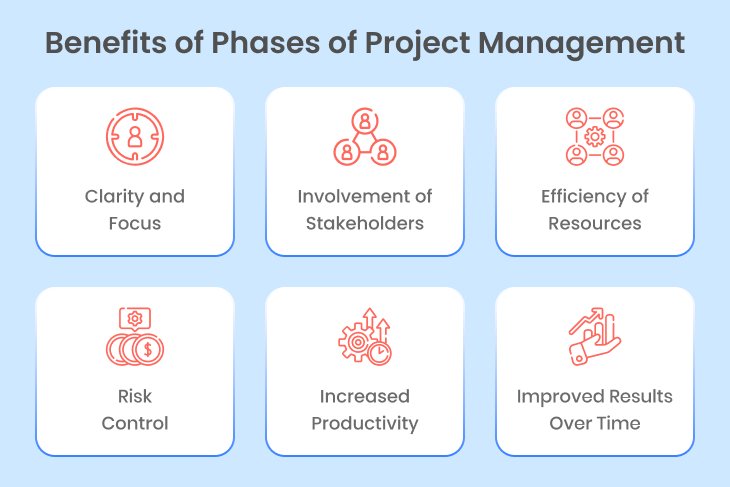However, you will truly benefit from an organized strategy that lays out your project phases if you are managing several difficult projects at once. We’ll define the five stages and discuss their many advantages in this tutorial. We’ll also provide you with useful advice to help you become an expert in every stage of the project management life cycle.
Benefits of phases of project management

- Clarity and focus: A project becomes far less daunting and more approachable when it is divided into several phases. This makes sure that every facet of the project is defined before any work is done, providing your team with a clear road map to follow to guarantee that no crucial aspects are missed.
- Involvement of stakeholders: Before your team begins any work, you may use the project life cycle phases to demonstrate why the project is important. Although it won’t ensure involvement, using this project management technique increases the likelihood that individuals will comprehend their responsibilities and the significance of their jobs.
- Efficiency of resources: Phases of project management help you get more use out of your current assets, including money, personnel, and equipment. It promotes proactive planning, which enables you to use the resources you currently have to complete better work in less time.
- Risk control: In the beginning stages of a project, you identify possible hazards. This provides an opportunity for your staff, including the kind people in legal and HR, to handle such liabilities before they arise.
- Increased productivity: Organizing a project into phases allows you to assess the team’s performance at regular intervals. Any differences between your project plan and the deliverables may be easily seen, allowing your team to address problems early on.
- Improved results over time: Future ventures benefit from the success of one already underway. By following this method, you may prevent making the same mistakes twice and create better initiatives in the future.
Five phases of project management
Project initiation
In the first stages of the project, there is a need to
- Describe the project’s business requirements.
- Do a feasibility assessment to ensure that the project can be carried out.
- List the stakeholders, project team, and team members who need to be notified.
Arrange a meeting to begin the process. Thereafter, draft the project charter, which specifies the goals and course of the project, during the meeting. It’s also not necessary to spend hours organizing this gathering.
Planning of project
Although the terms ‘initiation’ and ‘project planning’ may seem similar, they are not the same. You assemble a group of specialists and justify the project at the start-up phase. During the project planning stage, you draft a project plan that contains the following:
- A project schedule
- Deliverables in order of priority
- Project’s scope
- A work breakdown that divides work into smaller, easier-to-manage parts.
To examine the project plan at a high level and make any adjustments, visualize your project roadmaps using Board View using Alian Hub. Take your time creating a well-thought-out project plan that will make execution simple because, as the project manager, the entire project will depend on it.
Execution
Use dashboards that show your team’s progress in real-time. Create dashboards for each project or take a look at all of your projects. Furthermore, create an atmosphere where team members may openly exchange ideas and work together. Plan frequent meetings to receive status updates. Verify deliveries again for quality to avoid having to make significant changes later.
Tracking of project
Not every project has a defined beginning and finish. The project’s progress is monitored and compared to the metrics in your initial plan throughout the fourth phase. This is your time to change direction if the project isn’t going as planned so you can still meet your objectives. You can monitor the progress and know the hours spent on the project using the project time sheet provided by Alian Hub. Thus, tracking the project becomes a breeze.
Closure
It is necessary to close off projects in your project management software, but before you do so, arrange a post-report with your team. Meetings called for a post-examine of what went well and what may have been improved. Make a note of everything that went wrong or didn’t go as planned for the next project if you failed.
Conclusion
A proper approach is necessary for the effective management of the project and success of it. To guarantee that projects are properly defined, carried out, and completed, each stage is essential. Project managers may effectively negotiate the intricacies of every project and provide outcomes that meet or beyond stakeholders’ expectations by exercising careful planning, regular monitoring, and flexibility.

